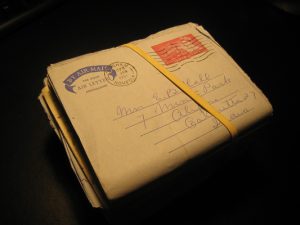The Problem:
For some time now, I have been pondering how best to deal with the mass of old family letters and other paperwork that I have managed to rescue from my late Pa’s house.
Many old letters have been badly damaged by the water ingress that occurred when thieves stole all the lead from the roof.
Some of the letters are well and truly stuck together in great “wodges”, and, to make matters even worse, some of these letters were written in “Quink”, the water-soluble ink that was so prevalent in the past!
As I work through them, I obviously need to distinguish one letter from the next – and many of them have unhelpful or unclear dates on them like “Sunday” rather than showing clearly the day, month and year when they were written. They were, of course, the “emails of their day” and so, in correspondence that was frequent, the dates were not really all that relevant at the time of writing. Sometimes the postmarks on the envelopes or aerogrammes are unclear or non-existent, which means that I will just have to guess from the contents of each letters as to when it might have been written.
I also need to note down whether or not they have been scanned and logged by me.
And yet I do not want to mark any of the original letters or other paperwork in any way even though, in this case, no one will object if I do so. It just seems “wrong” to destroy its current physical integrity by, for instance, adding a tiny sticky label with a number on it or “scrawling” a reference number on to a blank space on the document, even really lightly in pencil.
My Current Best Solution:
After consulting with a very experienced conservator recently, I have decided that the best approach will be to purchase a series of variously-sized (but probably mainly A4-sized) transparent pockets.
He suggested that I should choose the expensive sort, which are made out of acid-free and inert plastic, as, in theory at least, these should cause no damage to the paperwork.
The last thing I want is for the paperwork to get stuck to the insides of the plastic pockets, as has happened so frequently when I have put laser-printed paper in normal plastic pockets and then left them there for years and years.
By using pockets, this will enable me to label the pocket rather than what I have put in the pocket and it will also enable me to see clearly what is in the pocket.
The empty and filled pockets can then be filed in arch lever folders in whatever order makes most sense to me.
Once the pocket has been given a unique reference number, I can then scan the document, replace it in the plastic pocket and then log anything I want to against that number, for instance in text documents, spreadsheets and any of my various databases.
Would *You* Have Any Other Solutions To The Problem?
Please do feel free to add any other, potentially even better solutions.
This was very interesting. I look forward to your future articles.
Dear Clive,
Try Digitizing/Scanning EVERYTHING, in addition get an OCR software for whatever is type legible.
Buy lots of cheap disks (With backups/methods of your choice) so everything is available (Indexing of handwritten analogue stuff will be important).
Will keep you terribly busy but shunting/shuffling/searching for paper SHOULD end!